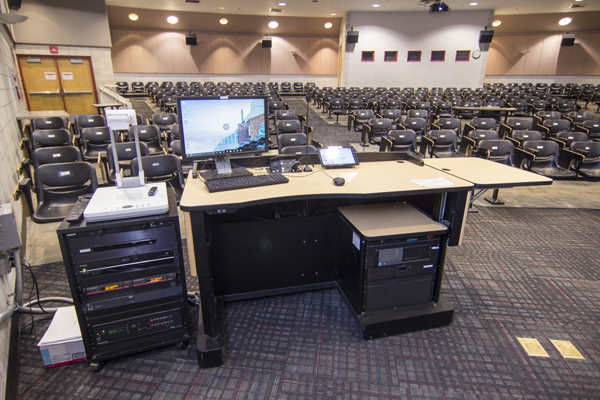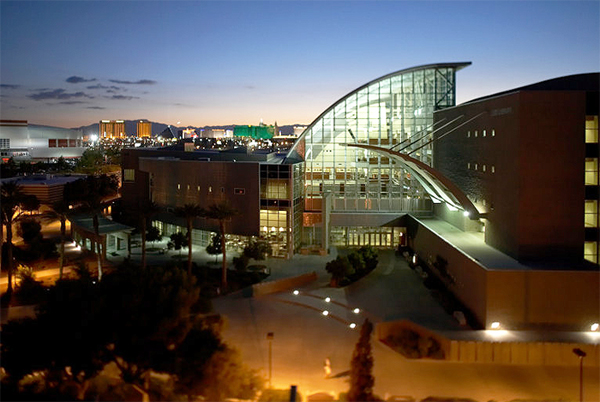UNLV Uses Data to Highlight the Value of a Well-Managed AV Operation
Posted on Oct 6, 2017
Much like the Maytag Repairman, when you’re doing a really, really good job of taking care of an institution’s technology infrastructure, it can be hard to get noticed. For years, the Office of Information Technology (OIT) at the University
of Nevada, Las Vegas (UNLV) had been quietly but diligently answering help-ticket calls and fixing problems with the AV systems in hundreds of classrooms used by 28,600 students and more than 2,900 faculty and staff. They were so good at it that between
academic years 2014-15 and 2016-17, help calls dropped from 802 to 609, a reduction of about 25 percent.  Normally, that’s good news. But in an ironic reversal of the “where there’s smoke, there’s fire” paradigm, the lack of urgency around the state of the university’s AV systems meant it was harder
to make the case for the increased budgets necessary for progressive updates to the school’s AV systems.
Normally, that’s good news. But in an ironic reversal of the “where there’s smoke, there’s fire” paradigm, the lack of urgency around the state of the university’s AV systems meant it was harder
to make the case for the increased budgets necessary for progressive updates to the school’s AV systems.“The only way you know that things are working is that you’re not getting help calls,” says Scott Menter, Manager of Classroom Technology Services for the OIT. In this situation, data analysis made the case for increasing the AV budget.
Data Collection Firepower
Not every campus technology department has the kind of integration firepower found at UNLV. Menter — whose own certifications include CTS®, DMC-D-4K — has four AVIXA CTS-certified technicians on his staff, two of whom are Crestron DigitalMedia-certified engineers. They included AV systems specialist Frank D. Alaimo, CTS-I, DMC-D-4K; and classroom control systems specialist Michael Theil, CTS, DMC-E-4K. The team collected data through the same BMC Footprints service management suite that the UNLV OIT uses to manage the IT service desk, and has been in use since 2012. “This helped us document and sort the types of issues we have during the semester,” says Menter. “What we were really interested in were the technical failures and operational issues.”
The OIT team established a set of data criteria that could be collected through the Fusion application. The list included:
- Button presses on each input source
- Time and date of the press
- Automatic shutdown events
- Length of time on that input source
- Length of time the projector was blanked
- Total time system is on
 Using data to determine where the biggest AV issues were located, protocols and sensor/monitoring protocols were developed that resulted in a decrease in the overall room-failure rate. For instance, the team created modules,
using the Fusion application, to deliver data from each classroom projector and developed an auto shutoff system: After three hours of detecting touch panel inactivity, one hour of “picture mute,” or 15 minutes of “no source detected,”
a warning will be displayed on the associated touch panel that the system will be shutting down.
Using data to determine where the biggest AV issues were located, protocols and sensor/monitoring protocols were developed that resulted in a decrease in the overall room-failure rate. For instance, the team created modules,
using the Fusion application, to deliver data from each classroom projector and developed an auto shutoff system: After three hours of detecting touch panel inactivity, one hour of “picture mute,” or 15 minutes of “no source detected,”
a warning will be displayed on the associated touch panel that the system will be shutting down.Systems Standardization
While cataloging the help tickets by type, the team discovered that most of the problems revolved around operational mistakes made by users. Analyzing the types of problems encountered, they attributed much to there being three different AV control systems that instructors had to maneuver. That led to a decision to standardize around Crestron’s Fusion platform, which also further bolstered team data-collection activities. For instance, Menter says, the Crestron Fusion monitoring application was able to record input such as who turned a system on and when, and for how long. This enabled the team to manage equipment life cycles and see actual equipment usage. Some modules were configured to enable Crestron Fusion to detect what AV input is selected, how long it is selected, and how many times it has been selected. “That got us down to a very granular level of data,” says Menter.
The outcome included a detailed analysis of room-utilization rates and a case for finally taking the school’s aging VCR decks out of the AV mix. “We were actually able to take the time, the date, how long, and who pushed the button on the VCR,” says Menter. “We can backtrack it through our 25Live scheduling application and can find the instructor who actually uses the VCR, so I can directly email them and let them know the VCRs are going out of style.”
Going Forward
But most importantly, the team could calculate a valid ROI for the effort, one that would act as the basis for increased funding for new AV platforms. The numbers are substantial: The collective useful lifespan of 128 projectors in the program is extended by more than 50,000 hours in total if the projectors are turned off when not in use. At an average of $500 per lamp, that created more than $8,000 in savings by not having to be replaced over a long span of time. At the upper end of the cost spectrum, more than $31,000 was saved in a single semester by properly shutting down the AV, which translates into an annual savings of $77,736. Across the 128 classrooms in the study, the total savings runs well into the millions of dollars.
Menter says that savings will provide a basis for determining future AV spending budgets.
A secondary but also critical collateral benefit to the study was how awareness of the OIT’s existence was enhanced. “Before this, we were the Rodney Dangerfield of the school,” Menter says only half in jest. “Now, the departments reach out to us directly when they have issues or questions. The data changed everything.”





